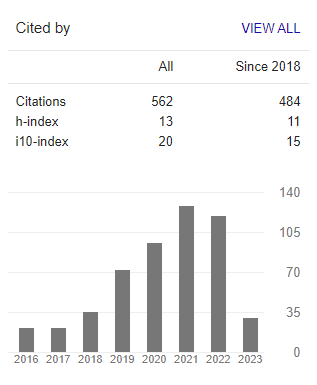PERPETUATING BEAUTY MYTH THROUGH SELFIE-EDITING
Abstract
Selfie is a phenomenon that best represents popular culture in today's digital era. The trend in the use of smartphones with front cameras and social media has contributed to the creation of 93 million selfies per day from Android-based phones alone. In fact, selfies are not something completely spontaneous and authentic. Selfies go through a series of processes of production and curation in various ways to bring out the 'best version' of a person. The awareness that selfies shared via social media will be seen, even commented on by others, makes individuals take a number of ways to 'enhance' their appearance virtually. One way to improve the appearance of yourself on a selfie is to do selfie-editing. This practice has been practiced and widely accepted. Selfie-editing is the process of perfecting selfies before they are uploaded and shared via social media platforms, especially Instagram. Instagram is currently the most popular social media platform for users to publish their selfie and other photographic contents. This article attempts to explain the selfie-editing phenomenon as an individual effort to manage impressions through the concept of looking-glass self by Charles Horton Cooley. The research was conducted qualitatively, namely by conducting in-depth interviews with informants who are influencers on Instagram, as well as observing and analyzing selfies and photos published in each of the influencers' Instagram accounts. The three accounts that had been the object of this research are @cindaranii, @indripurwandari, and @ipehkhalifah. The three users consistently posted their selfies and self-portraits with various arrangements in their Instagram feeds, as they have thousands of Instagram followers. The findings show that selfies undergo some specific and organized process which can be classified into 3 phases: Pre-production, Production, and Post-Production. These processes indicate that a selfie needs to meet some criteria prior to its uploads in Instagram. This study also found that selfie-editing or photo-editing is certain, but such editing and modification process should deliver a natural and effortless look, the least fabricated it could be. This indicates that selfie-editing is not only a form of impression management on social media, but also a form of censorship action according to the myth of beauty, even though the internet and social media are often perceived as a free and democratic medium.
Keywords: Selfie, Selfie-editing, Looking-glass self, Self-censorship, Beauty Myth
To cite this article (7th APA style):
Setyastuti, M. P., & Sunuantari, M. (2021). Perpetuating beauty myth through selfie-editing in Instagram. Journal Communication Spectrum: Capturing New Perspectives in Communication, 11(1), 26-38. http://dx.doi.org/10.36782/jcs.v11i1.2128Keywords
References
Abidin, C. (2016). “Aren’t these just young, rich women doing vain things online?”: Influencer selfies as subversive frivolity. Social Media + Society, 2(2), 13-29. https://doi.org/10.1177/2056305116641342
Agustin, S. M. (2009). Foucault dan komunikasi (telaah konstruksi wacana dan kuasa foucault dalam lingkup komunikasi). Jurnal Ilmu Komunikasi, 7(3), 199-211. https://doi.org/10.31315/jik.v7i3.27
Albury, K. (2015). Selfies, sexts, and sneaky hats: Young people’s understandings of gendered practices of self-representation. International Journal of Communication, 9(11), 1734–1745. https://ijoc.org/index.php/ijoc/article/view/3132/1396
Aziliya, D. (2014, December 31). Selfie dinobatkan sebagai kata terpopuler tahun ini. KABAR24 - Bisnis Indonesia. https://kabar24.bisnis.com/read/20141231/79/387067/selfie-dinobatkan-jadi-kata-terpopuler-tahun-ini
Barker, V., & Rodriguez, N. S. (2009). This is who I am: The selfie as a personal and social identity marker. International Journal of Communication, 13(24), 1143–1166. https://ijoc.org/index.php/ijoc/article/view/9723
Boursier, V., Gioia, F., & Griffiths, M. D. (2020). Do selfie-expectancies and social appearance anxiety predict adolescents’ problematic social media use? Computers in Human Behavior, 110, 106395. https://doi.org/10.1016/j.chb.2020.106395
Bue, A. C. C. (2020). The looking glass selfie: Instagram use frequency predicts visual attention to high-anxiety body regions in young women. Computers in Human Behavior, 108, 106329. https://doi.org/10.1016/j.chb.2020.106329
Clement, J. (2020, October 29). Leading countries based on Instagram audience size as of January 2020 (in millions). Statista. Retrieved December 2020, from https://www.statista.com/statistics/ 578364/countries-with-most-instagram-users/
Crable, B. (2009). Symbolic interactionism. In S. W. Littlejohn & K. A. Foss (Eds.), Encyclopedia of communication theory (Vol. 1, pp. 946-948). SAGE Publications. https://doi.org/10.4135/9781412959384.n371
Dhona, H. R. (2019). Analisis wacana Foucault dalam studi komunikasi. Journal Communication Spectrum: Capturing New Perspectives in Communication, 9(1), 189-208. https://doi.org/10.36782/jcs.v9i1.2026
Hasan, A. M. (2016, September 9). Selfie boleh, mati jangan. Tirto.ID. https://tirto.id/selfie-boleh-mati-jangan-bH66
Haryatmoko, J. (2016). Membongkar rezim kepastian: Pemikiran kritis post-strukturalis. Kanisius.
Jiyoung, C. (2017). Virtual makeover: Selfie-taking and social media use increase selfie-editing frequency through social comparison. Computers in Human Behavior, 66, 370-376. https://doi.org/10.1016/j.chb.2016.10.007
Lobinger, K., & Brantner, C. (2015). In the eye of the beholder: Subjective views on the authenticity of selfies. International Journal of Communication, 9(13), 1848–1860. https://ijoc.org/index.php/ijoc/article/view/3151/1404
McLeod, S. (2007, February 5). Maslow's hierarchy of needs. Simply Psychology. https://www.simplypsychology.org/maslow.html
Miller, K. (2011). Organizational communication: Approaches and processes (6th ed.). Cengage Learning.
Purwati, P. (2015). Fenomena Selfie Kalangan Remaja Perempuan di Instagram [Bachelor's thesis, Universitas Diponegoro]. Neliti. https://www.neliti.com/id/publications/188402/
Rettberg, J. W. (2014). Seeing ourselves through technology: How we use selfies, blogs, and wearable devices to see and shape ourselves. Springer/Palgrave Macmillan. https://doi.org/10.1057/9781137476661
Senft, T. M., & Baym, N. K. (2015). What does the selfie say? Investigating a global phenomenon. International Journal of Communication, 9(2), 1588–1606. https://ijoc.org/index.php/ijoc/article/view/4067
The Renfrew Center Foundation. (2014, February 20). Afraid to be your Selfie? Survey reveals most people Photoshop their images. https://renfrewcenter.com/news/afraid-be-your-selfie-survey-reveals-most-people-photoshop-their-images
Tiidenberg, K. (2018a). What are selfies? In Selfies: Why we love (and hate) them (society now) (pp. 17-46). Emerald Publishing. https://doi.org/10.1108/978-1-78754-357-720181010
Tiidenberg, K. (2018b). (Why) Do selfies matter? In Selfies: Why we love (and hate) them (society now) (pp. 75-100). Emerald Publishing. https://doi.org/10.1108/978-1-78754-357-720181003
Wolf, N. (2004). Mitos kecantikan: Kala kecantikan menindas perempuan (A. Swastika, Trans.). Niagara. (Original work published 1990).
Refbacks
- There are currently no refbacks.

This work is licensed under a Creative Commons Attribution 3.0 License.
Indexed by:
Archived in:
Listed in:
INTERNATIONAL ASSOCIATION FOR MEDIA AND COMMUNICATION RESEARCH

















